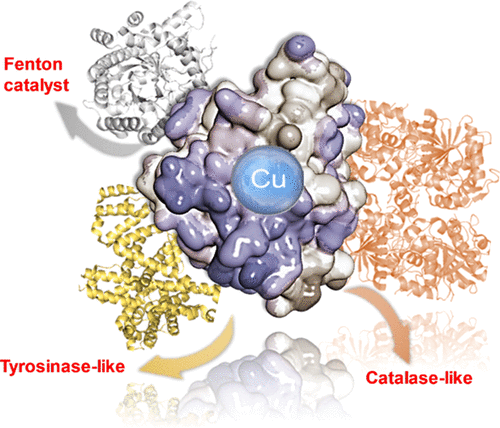当前位置:
X-MOL 学术
›
ACS Appl. Mater. Interfaces
›
论文详情
Our official English website, www.x-mol.net, welcomes your feedback! (Note: you will need to create a separate account there.)
Enzyme/Nanocopper Hybrid Nanozymes: Modulating Enzyme-like Activity by the Protein Structure for Biosensing and Tumor Catalytic Therapy
ACS Applied Materials & Interfaces ( IF 9.5 ) Pub Date : 2021-01-20 , DOI: 10.1021/acsami.0c20501 Noelia Losada-Garcia 1 , Ana Jimenez-Alesanco 2 , Adrian Velazquez-Campoy 2, 3, 4, 5, 6 , Olga Abian 2, 4, 5, 6, 7 , Jose M Palomo 1
ACS Applied Materials & Interfaces ( IF 9.5 ) Pub Date : 2021-01-20 , DOI: 10.1021/acsami.0c20501 Noelia Losada-Garcia 1 , Ana Jimenez-Alesanco 2 , Adrian Velazquez-Campoy 2, 3, 4, 5, 6 , Olga Abian 2, 4, 5, 6, 7 , Jose M Palomo 1
Affiliation

|
Artificial enzymes with modulated enzyme-mimicking activities of natural systems represent a challenge in catalytic applications. Here, we show the creation of artificial Cu metalloenzymes based on the generation of Cu nanoparticles in an enzyme matrix. Different enzymes were used, and the structural differences between the enzymes especially influenced the controlled the size of the nanoparticles and the environment that surrounds them. Herein, we demonstrated that the oxidase-like catalytic activity of these copper nanozymes was rationally modulated by enzyme used as a scaffold, with a special role in the nanoparticle size and their environment. In this sense, these nanocopper hybrids have confirmed the ability to mimic a unique enzymatic activity completely different from the natural activity of the enzyme used as a scaffold, such as tyrosinase-like activity or as Fenton catalyst, which has extremely higher stability than natural mushroom tyrosinase. More interestingly, the oxidoreductase-like activity of nanocopper hybrids was cooperatively modulated with the synergistic effect between the enzyme and the nanoparticles improving the catalase activity (no peroxidase activity). Additionally, a novel dual (metallic and enzymatic activity) of the nanozyme made the highly improved catechol-like activity interesting for the design of 3,4-dihydroxy-l-phenylalanine (l-DOPA) biosensor for detection of tyrosinase. These hybrids also showed cytotoxic activity against different tumor cells, interesting in biocatalytic tumor therapy.
中文翻译:

酶/纳米铜杂化纳米酶:通过蛋白质结构调节酶样活性用于生物传感和肿瘤催化治疗
具有调节天然系统酶模拟活性的人工酶代表了催化应用中的挑战。在这里,我们展示了基于在酶基质中生成铜纳米颗粒的人工铜金属酶的创建。使用了不同的酶,酶之间的结构差异尤其影响了纳米粒子的大小和周围环境的控制。在此,我们证明了这些铜纳米酶的类氧化酶催化活性受到用作支架的酶的合理调节,对纳米颗粒大小及其环境具有特殊作用。从这个意义上说,这些纳米铜杂化物已经证实了能够模拟与用作支架的酶的天然活性完全不同的独特酶活性,如酪氨酸酶样活性或芬顿催化剂,比天然蘑菇酪氨酸酶具有极高的稳定性。更有趣的是,纳米铜杂化物的氧化还原酶样活性与酶和纳米颗粒之间的协同效应共同调节,提高过氧化氢酶活性(无过氧化物酶活性)。此外,纳米酶的新型双重(金属和酶活性)使高度改进的邻苯二酚样活性对于设计 3,4-二羟基- 纳米铜杂化物的氧化还原酶样活性与酶和纳米颗粒之间的协同作用共同调节,提高过氧化氢酶活性(无过氧化物酶活性)。此外,纳米酶的新型双重(金属和酶活性)使高度改进的邻苯二酚样活性对于设计 3,4-二羟基- 纳米铜杂化物的氧化还原酶样活性与酶和纳米颗粒之间的协同作用共同调节,提高过氧化氢酶活性(无过氧化物酶活性)。此外,纳米酶的新型双重(金属和酶活性)使高度改进的邻苯二酚样活性对于设计 3,4-二羟基-l -苯丙氨酸 ( l -DOPA) 生物传感器,用于检测酪氨酸酶。这些杂交体还显示出对不同肿瘤细胞的细胞毒活性,这在生物催化肿瘤治疗中很有趣。
更新日期:2021-02-03
中文翻译:

酶/纳米铜杂化纳米酶:通过蛋白质结构调节酶样活性用于生物传感和肿瘤催化治疗
具有调节天然系统酶模拟活性的人工酶代表了催化应用中的挑战。在这里,我们展示了基于在酶基质中生成铜纳米颗粒的人工铜金属酶的创建。使用了不同的酶,酶之间的结构差异尤其影响了纳米粒子的大小和周围环境的控制。在此,我们证明了这些铜纳米酶的类氧化酶催化活性受到用作支架的酶的合理调节,对纳米颗粒大小及其环境具有特殊作用。从这个意义上说,这些纳米铜杂化物已经证实了能够模拟与用作支架的酶的天然活性完全不同的独特酶活性,如酪氨酸酶样活性或芬顿催化剂,比天然蘑菇酪氨酸酶具有极高的稳定性。更有趣的是,纳米铜杂化物的氧化还原酶样活性与酶和纳米颗粒之间的协同效应共同调节,提高过氧化氢酶活性(无过氧化物酶活性)。此外,纳米酶的新型双重(金属和酶活性)使高度改进的邻苯二酚样活性对于设计 3,4-二羟基- 纳米铜杂化物的氧化还原酶样活性与酶和纳米颗粒之间的协同作用共同调节,提高过氧化氢酶活性(无过氧化物酶活性)。此外,纳米酶的新型双重(金属和酶活性)使高度改进的邻苯二酚样活性对于设计 3,4-二羟基- 纳米铜杂化物的氧化还原酶样活性与酶和纳米颗粒之间的协同作用共同调节,提高过氧化氢酶活性(无过氧化物酶活性)。此外,纳米酶的新型双重(金属和酶活性)使高度改进的邻苯二酚样活性对于设计 3,4-二羟基-l -苯丙氨酸 ( l -DOPA) 生物传感器,用于检测酪氨酸酶。这些杂交体还显示出对不同肿瘤细胞的细胞毒活性,这在生物催化肿瘤治疗中很有趣。



























 京公网安备 11010802027423号
京公网安备 11010802027423号